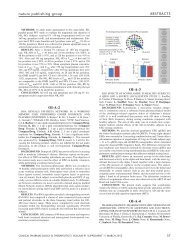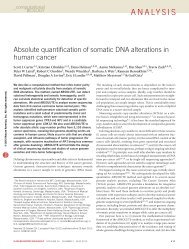open access: Nature Reviews: Key Advances in Medicine
open access: Nature Reviews: Key Advances in Medicine
open access: Nature Reviews: Key Advances in Medicine
Create successful ePaper yourself
Turn your PDF publications into a flip-book with our unique Google optimized e-Paper software.
GASTROENTEROLOGY & HEPATOLOGY<br />
HEPATITIS C IN 2011<br />
A new standard of care and the race towards<br />
IFN-free therapy<br />
Wolf Peter Hofmann and Stefan Zeuzem<br />
Chronic HCV <strong>in</strong>fection is a lead<strong>in</strong>g cause of liver-related morbidity and mortality. In 2011, treatment options for<br />
patients <strong>in</strong>fected with HCV genotype 1 changed dramatically with the approval of two nonstructural prote<strong>in</strong> 3<br />
protease <strong>in</strong>hibitors—boceprevir and telaprevir—by the FDA and the European Medic<strong>in</strong>es Agency.<br />
Hofmann, W. P. & Zeuzem, S. Nat. Rev. Gastroenterol. Hepatol. 9, 67–68 (2012); published onl<strong>in</strong>e 20 December 2011; doi:10.1038/nrgastro.2011.249<br />
In phase III cl<strong>in</strong>ical trials, the comb<strong>in</strong>ation<br />
of boceprevir or telaprevir with PEG-<br />
IFN-α–ribavir<strong>in</strong> has been shown to result<br />
<strong>in</strong> <strong>in</strong>creased susta<strong>in</strong>ed virological response<br />
(SVR) rates compared with PEG-IFN-α–<br />
ribavir<strong>in</strong> (67–75% and 38–44%, respectively)<br />
<strong>in</strong> therapy-naive patients. 1,2 As<br />
these new triple therapies also resulted <strong>in</strong><br />
<strong>in</strong>creased rapid virological response (RVR;<br />
undetectable levels of HCV RNA at week 4<br />
of triple therapy) rates, response-guided<br />
therapy to shorten the duration of treatment<br />
from 48 weeks to 24–28 weeks is now<br />
possible for a large proportion of patients.<br />
Additional phase III cl<strong>in</strong>ical trials showed<br />
that many patients who did not respond<br />
RVR and SVR (%)<br />
100 –<br />
90 –<br />
80 –<br />
70 –<br />
60 –<br />
50 –<br />
40 –<br />
30 –<br />
20 –<br />
10 –<br />
RVR<br />
SVR<br />
0 –<br />
BMS-790052 +<br />
BMS-650032<br />
BMS-790052 +<br />
BMS-650032 +<br />
PEG-IFN-α–RBV<br />
well to previous PEG-IFN-α–ribavir<strong>in</strong><br />
therapies also benefited from re-treatment<br />
with PEG-IFN-α–ribavir<strong>in</strong> and boceprevir<br />
or telaprevir. 3,4 Patients who had previously<br />
relapsed achieved SVR rates of 69–88%<br />
when re-treated, and previous partial<br />
responders showed SVR rates of 40–59%.<br />
In those who had a previous null response,<br />
SVR rates follow<strong>in</strong>g re-treatment were still<br />
poor (33% for telaprevir). 4<br />
Despite these encourag<strong>in</strong>g achievements<br />
for patients <strong>in</strong>fected with HCV genotype 1,<br />
the low tolerability, particularly for PEG-<br />
IFN-α, and the emergence of resistant<br />
variants associated with treatment failure<br />
of triple therapies that <strong>in</strong>clude boce previr<br />
BMS-790052 +<br />
BMS-650032<br />
PSI-7977 PSI-7977 +<br />
RBV12<br />
or telaprevir are still major drawbacks.<br />
Furthermore, current dos<strong>in</strong>g schedules are<br />
complex and the pill burden is high, which<br />
might result <strong>in</strong> suboptimal adherence to<br />
treatment. Comb<strong>in</strong>ation therapies with two<br />
direct-act<strong>in</strong>g antiviral agents (DAAs) that<br />
have different modes of action, and an alloral<br />
IFN-free DAA therapy should overcome<br />
resistance, reduce the <strong>in</strong>cidence of adverse<br />
events and improve treatment adherence.<br />
Different substance classes with anti-HCV<br />
activity <strong>in</strong>clude nonstructural prote<strong>in</strong> (NS)<br />
3 protease <strong>in</strong>hibitors, NS5A <strong>in</strong>hibitors, and<br />
nucleoside <strong>in</strong>hibitors and non-nucleoside<br />
<strong>in</strong>hibitors of the HCV NS5B polymerase.<br />
Results of several trials of DAA comb<strong>in</strong>ation<br />
PSI-7977 +<br />
RBV12 +<br />
PEG-IFN-α (4)<br />
PSI-7977 +<br />
RBV12 +<br />
PEG-IFN-α (8)<br />
PSI-7977 +<br />
RBV12 +<br />
PEG-IFN-α (12)<br />
Study 1 Study 2 Study 3<br />
Figure 1 | The effectiveness of an all-oral IFN-free therapy for patients with HCV has been demonstrated <strong>in</strong> some study arms of three recent trials.<br />
Patients <strong>in</strong> study 1 had HCV genotype 1a or 1b <strong>in</strong>fection and previously a null response to PEG-IFN-α–RBV. 8 These patients received 200 mg of the<br />
protease <strong>in</strong>hibitor BMS-650032 twice a day plus 60 mg of the NS5A <strong>in</strong>hibitor BMS-790052 once a day with or without PEG-IFN-α–RBV for 24 weeks.<br />
Patients with viral breakthrough dur<strong>in</strong>g dual therapy received PEG-IFN-α–RBV and achieved SVR thereafter (not shown). Patients <strong>in</strong> study 2 all had HCV<br />
genotype 1b and had previously had a null response to PEG-IFN-α–RBV. 9 These patients received 200 mg of the protease <strong>in</strong>hibitor BMS-650032 twice<br />
a day and 60 mg of the NS5A <strong>in</strong>hibitor BMS-790052 once a day for 24 weeks. Patients <strong>in</strong> study 3 had HCV genotypes 2 or 3 and were treatment<br />
naive. 10 These patients all received 400 mg of the nucleoside <strong>in</strong>hibitor PSI-7977 once a day as monotherapy or with RBV for 12 weeks. Three arms<br />
also received PEG-IFN-α for 4, 8 or 12 weeks. Abbreviations: RBV, ribavir<strong>in</strong>; RVR, rapid virological response; SVR, susta<strong>in</strong>ed virological response.<br />
KEY ADVANCES IN MEDICINE JANUARY 2012 | S33








